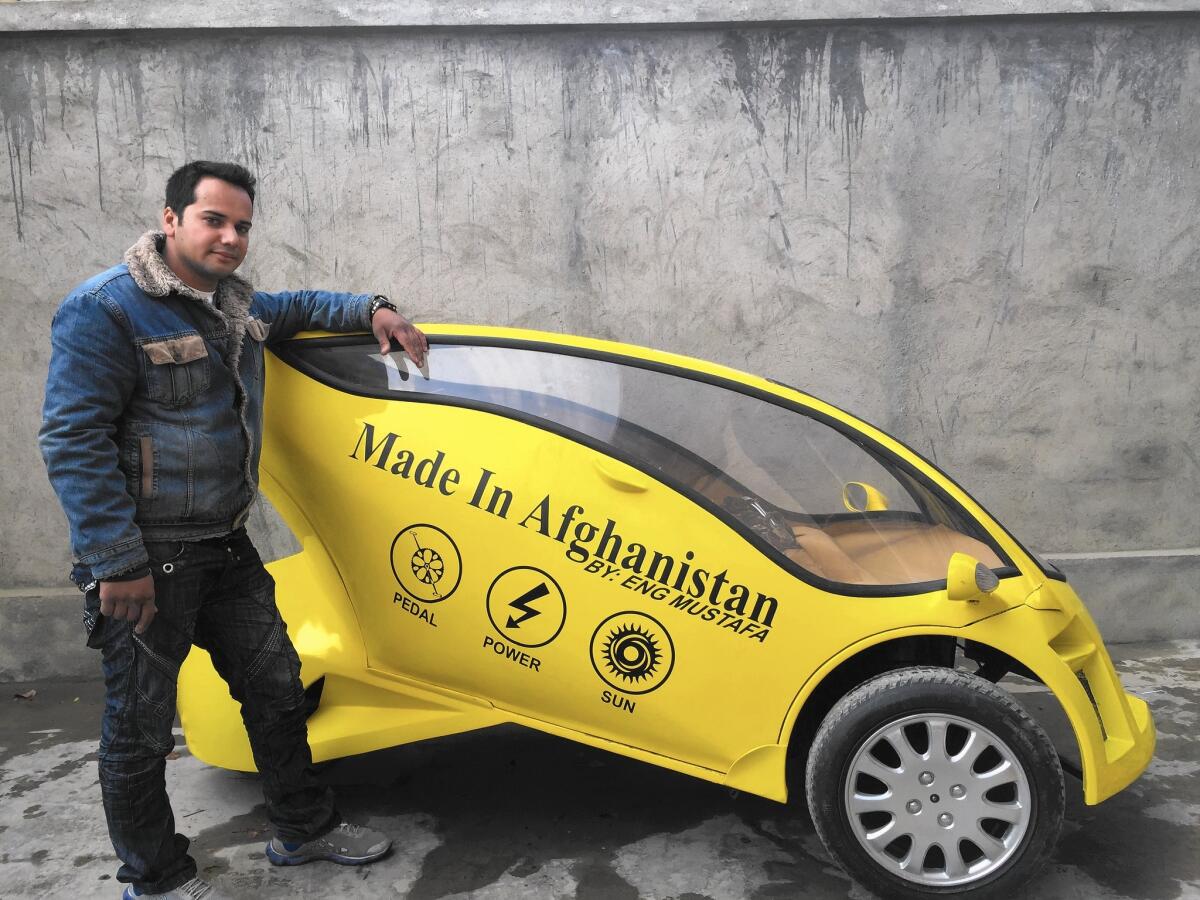A solar-powered motorbike, to empower Afghans

Mustafa Mohammadi of Kabul, Afghanistan, a self-trained engineer, has built a solar-powered motorbike.
- Share via
reporting from Kabul, Afghanistan — When Mustafa Mohammadi told his parents he wanted to spend tens of thousands of afghanis and several weeks building a solar-powered motorbike, they thought he was delusional.
“There’s no guarantee the thing will work,” his father told him.
His mother worried that the endeavor would call unwanted attention to their family.
“Someone could steal it, or worse yet, they could hurt you to get to it,” she said.
Mohammadi knew his mother’s concern wasn’t without warrant; at least six people have been shot in his north Kabul neighborhood this year.
But the 30-year-old self-trained engineer pressed on.
“I knew I had to do it, to show the world and the Afghan people that we are capable of our own technological advances,” Mohammadi said.
However, relying on products available in the Afghan market presented several hurdles. Though he was able to easily acquire the five solar panels for the roof of the vehicle at a cost of 1,800 afghanis — about $35 — a suitable battery proved more problematic.
Mohammadi’s original plan called for a 180-volt battery with plenty of storage capacity, but he had to make do with the 60-volt Pakistani-made models available in Kabul.
Despite the setback, Mohammadi pressed on.
During the month-and-a-half-long process, he kept adjusting his designs to suit the situation on Kabul’s crowded streets.
“A traditional motorcycle is unsafe and won’t withstand the elements, especially in the winter,” he said. “So I decided to put on a roof to shield the driver from rain and snow.”
After an unexpectedly brutal winter that saw large avalanches and floods throughout several eastern and northern provinces, Mohammadi made sure the design for the two-person vehicle would not require water for cooling — because it might freeze — or a warm-up for the engine before driving. “It can take off right away.”
With the Ministry of Public Health citing air pollution as a leading cause of illnesses being treated in the capital’s hospitals, Mohammadi built in two alternative petroleum-free methods for powering the vehicle.
“The solar panels are capable of fully charging the battery, but for days when there is no sun or electricity, I put in pedals,” Mohammadi said.
When the prototype was completed in mid-December, the bright yellow vehicle quickly became an attraction. “Whenever anyone takes it out for a test drive you will see dozens of people gathered around.”
The vehicle has even caught the attention of First Lady Rula Ghani, who hung a picture of it in her office in the presidential palace as a symbol of the accomplishments of young Afghans.
But the unique design also leaves many people wondering how exactly to operate the vehicle. When a crew from TOLO TV, the nation’s largest private television channel, came around, the reporter insisted on driving it.
“I told him to be careful; this isn’t a car or a traditional motorcycle, but he didn’t listen. He just took off down the street.”
As the vehicle reached its top speed of nearly 25 mph, the reporter lost control and hit the car of a neighboring family.
Traffic officers too have been unsure of how to react to the vehicle. When Mohammadi took it for a test drive along the road leading to the Pol-e Charkhi prison outside Kabul, he was stopped several times along the way.
“They would pull me over to ask for the registration documents, but the city has yet to provide me with one. They don’t know how to classify it. Others would tell me to take it off the road.”
Nasrin, Mohammadi’s mother, said she is proud of her son for taking his lifelong passion and putting it to use to address the city’s traffic and pollution problems. She is especially pleased that her son has been able to advance his pursuits as an inventor without a formal engineering education.
However, the media attention has done little to assuage her fear for her son’s safety.
Previously, Mohammadi modified a three-wheeled Honda motorcycle for a disabled driver who had lost his right arm, a continuation, he said, of his efforts to provide suitable transportation for the city’s disabled population, estimated at 400,000 to 656,000.
Though Mohammadi has been heralded for his innovations, he is not the only young Afghan to gain attention for mathematical and scientific prowess.
In 2012, a high school student in the eastern province of Ghazni came up with a math formula that was approved by the Kabul center for science. A robotic excavator designed by another teenager in Logar province recently caught the attention of former President Hamid Karzai.
Mohammadi said several people have approached him to suggest that he hand his designs to Chinese or Pakistani firms that can mass produce the vehicle.
“I could, but that would defeat the purpose,” he said. “If the government can help me gather the proper documentation, why wouldn’t I put Afghans to work rather than foreigners?”
Mohammadi, who plans to create a helicopter, said he seeks only the support of the government of President Ashraf Ghani, which has made youth employment a top priority.
“If they can help me obtain a scholarship to study somewhere where I can properly learn engineering, think of all the Afghans I can help put to work.”
Latifi is a special correspondent.
More to Read
Sign up for Essential California
The most important California stories and recommendations in your inbox every morning.
You may occasionally receive promotional content from the Los Angeles Times.













